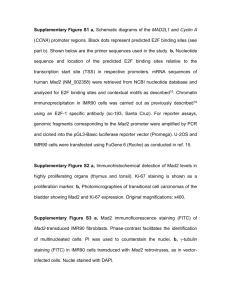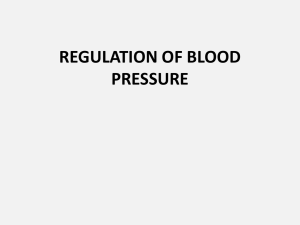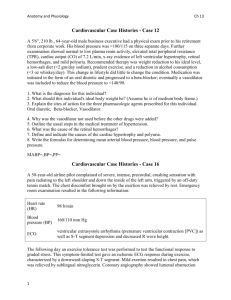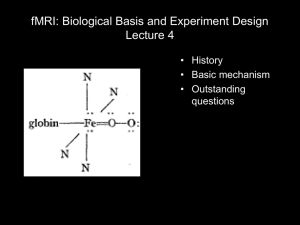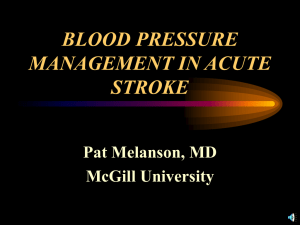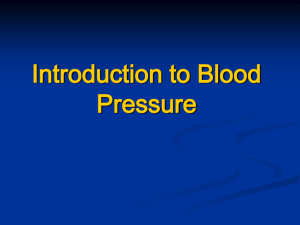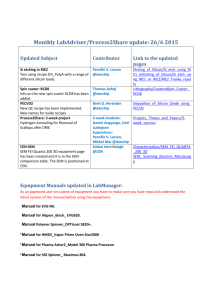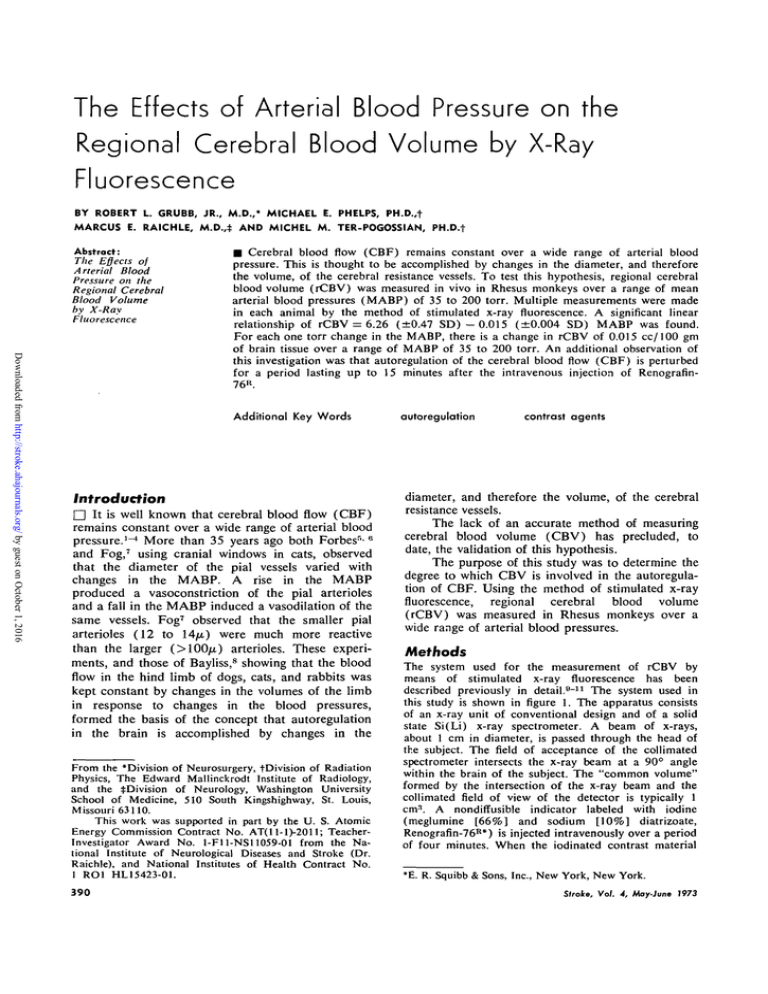
The Effects of Arterial Blood Pressure on the
Regional Cerebral Blood Volume by X-Ray
Fluorescence
BY ROBERT L. GRUBB, JR., M.D.,* MICHAEL E. PHELPS, PH.D.,f
MARCUS E. RAICHLE, M.D.,} AND MICHEL M. TER-POGOSSIAN, PH.D.f
Abstract:
The Effects of
A rterial Blood
Pressure on the
Regional Cerebral
Blood Volume
by X-Ray
Fluorescence
Downloaded from http://stroke.ahajournals.org/ by guest on October 1, 2016
• Cerebral blood flow (CBF) remains constant over a wide range of arterial blood
pressure. This is thought to be accomplished by changes in the diameter, and therefore
the volume, of the cerebral resistance vessels. To test this hypothesis, regional cerebral
blood volume (rCBV) was measured in vivo in Rhesus monkeys over a range of mean
arterial blood pressures (MABP) of 35 to 200 torr. Multiple measurements were made
in each animal by the method of stimulated x-ray fluorescence. A significant linear
relationship of rCBV = 6.26 (±0.47 SD) - 0 . 0 1 5 (±0.004 SD) MABP was found.
For each one torr change in the MABP, there is a change in rCBV of 0.015 cc/100 gm
of brain tissue over a range of MABP of 35 to 200 torr. An additional observation of
this investigation was that autoregulation of the cerebral blood flow (CBF) is perturbed
for a period lasting up to 15 minutes after the intravenous injection of Renografin76R.
Additional Key Words
Introduction
• It is well known that cerebral blood flow (CBF)
remains constant over a wide range of arterial blood
pressure.1-* More than 35 years ago both Forbes5' 8
and Fog,7 using cranial windows in cats, observed
that the diameter of the pial vessels varied with
changes in the MABP. A rise in the MABP
produced a vasoconstriction of the pial arterioles
and a fall in the MABP induced a vasodilation of the
same vessels. Fog7 observed that the smaller pial
arterioles (12 to 14/n) were much more reactive
than the larger (>100yn) arterioles. These experiments, and those of Bayliss,8 showing that the blood
flow in the hind limb of dogs, cats, and rabbits was
kept constant by changes in the volumes of the limb
in response to changes in the blood pressures,
formed the basis of the concept that autoregulation
in the brain is accomplished by changes in the
From the 'Division of Neurosurgery, tDivision of Radiation
Physics, The Edward Mallinckrodt Institute of Radiology,
and the ^Division of Neurology, Washington University
School of Medicine, 510 South Kingshighway, St. Louis,
Missouri 63110.
This work was supported in part by the U. S. Atomic
Energy Commission Contract No. AT(ll-l)-2011; TeacherInvestigator Award No. 1-F11-NS11059-01 from the National Institute of Neurological Diseases and Stroke (Dr.
Raichle), and National Institutes of Health Contract No.
1 RO1 HL15423-01.
390
autoregulation
contrast agents
diameter, and therefore the volume, of the cerebral
resistance vessels.
The lack of an accurate method of measuring
cerebral blood volume (CBV) has precluded, to
date, the validation of this hypothesis.
The purpose of this study was to determine the
degree to which CBV is involved in the autoregulation of CBF. Using the method of stimulated x-ray
fluorescence, regional cerebral blood volume
(rCBV) was measured in Rhesus monkeys over a
wide range of arterial blood pressures.
Methods
The system used for the measurement of rCBV by
means of stimulated x-ray fluorescence has been
described previously in detail.0-11 The system used in
this study is shown in figure 1. The apparatus consists
of an x-ray unit of conventional design and of a solid
state Si (Li) x-ray spectrometer. A beam of x-rays,
about 1 cm in diameter, is passed through the head of
the subject. The field of acceptance of the collimated
spectrometer intersects the x-ray beam at a 90° angle
within the brain of the subject. The "common volume"
formed by the intersection of the x-ray beam and the
collimated field of view of the detector is typically 1
cm3. A nondiffusible indicator labeled with iodine
(meglumine [66%] and sodium [10%] diatrizoate,
Renografin-76R#) is injected intravenously over a period
of four minutes. When the iodinated contrast material
*E. R. Squibb & Sons, Inc., New York, New York.
Stroke, Vol. 4, May-June 1973
EFFECTS OF ARTERIAL BLOOD PRESSURE
Downloaded from http://stroke.ahajournals.org/ by guest on October 1, 2016
FIGURE 1
Diagram of x-ray fluorescence system.
equilibrates in the vascular pool, the x-ray tube is
activated, which excites the iodine in the common
volume, and the characteristic K shell fluorescence of
iodine, consisting of 28.5 and 32.4 kev x-rays, is
emitted and detected by the x-ray spectrometer. The
intensity of the iodine fluorescent radiation is proportional, within limits, to the amount of indicator in the
common volume. Samples of the subject's blood drawn
simultaneous to the cerebral measurement are later
"fluoresced" in a suitable brain phantom. The rCBV is
then calculated from the ratio of the fluorescence signal
in the brain to that of the blood. About one minute is
required to make a measurement of rCBV with this
method. Several measurements can be made until the
level of contrast material has fallen to a nondetectable
level, due to its clearance from the blood by the
kidneys. Because Renografin-76K is a plasma tag, all of
the rCBV values obtained in this experiment were
corrected for a cerebral hematocrit of 85% of the large
vessel hematocrit.10' n
Ten adult Rhesus monkeys weighing 12 to 14 lb
were anesthetized with phencyclidine HC1, and given
atropine. The monkeys were paralyzed with gallamine
triethiodide, and passively ventilated on 100% oxygen
with a Harvard respirator. Arterial blood pressure was
monitored with a catheter placed in the aorta through
the femoral artery and connected to a Statham P23aa
Stroke, Vol. 4. May-June 1973
transducer. A femoral vein catheter was used for
infusion of drugs and withdrawal of blood when the
blood pressure was lowered. The end tidal CO2 was
monitored with a Beckman Model LB-1 capnograph.
pH, PCOv, and Po., were determined on multiple arterial
and venous blood samples with an IL-113 gas analyzer.
The animal was maintained at a constant temperature
of 37 to 38°C with a heating pad. Superior sagittal sinus
blood samples were obtained from several animals
through direct puncture of the superior sagittal sinus via
a Teflon appliance chronically implanted through a
small craniectomy directly over the sinus. This
appliance allows repeated superior sagittal sinus blood
samples to be obtained without disruption of the
sinus.
The anesthetized and paralyzed monkeys were
positioned on the fluorescence table so that the
target volume was located in the midportion of the
posterior frontal lobe. The position of the target volume
was verified by making a skull film of the monkey and a
double exposure of the collimated x-ray beam. The
position of the field of acceptance of the collimated
detector was determined by external measurement.10' u
The P&CO., w a s maintained at a constant level within the
normal range of 32 to 46 torr throughout the
experiment. The animals were infused with 0.75 cc per
pound of Renografin-76R over a four-minute period. A
measurement of rCBV was obtained at the animals'
baseline MABP. The MABP was then increased by a
constant intravenous infusion of either metaraminol or
angiotensin. When the MABP was stabilized at an
elevated level, one or two measurements were made.
The infusion of pressor agent was then stopped and the
MABP was allowed to return to baseline values. Again,
rCBV was measured at the baseline MABP level. When
the MABP had stabilized, a third baseline rCBV value
was obtained. The MABP was then lowered and
stabilized by the rapid withdrawal of approximately 80
to 100 cc of blood from the femoral vein catheter. One
or two measurements were made before the MABP was
elevated by the re-infusion of the withdrawn blood
(infusion period of one to two minutes). Within three
to four minutes after the re-infusion of the blood, a
measurement of rCBV was obtained. The sequence of
changes in the MABP was varied in some experiments
with an initial lowering of the MABP, followed by
elevation of the MABP. In other experiments, the
MABP was raised two to three times in sequence and
several rCBV measurements were obtained. A total of
five to ten measurements of rCBV were made in each
experiment. In some of the experiments the arterial P Oo
and superior sagittal sinus P 0 2 were determined during
the rCBV measurements. The reciprocal of arteriovenous oxygen difference across the brain was then used
as an index of CBF.12 The values of rCBV obtained
were corrected to a common PaCo2 of 40 torr using a
CO;, responsiveness of 0.046 cc per 1 torr of Pa c 0 .,. n
Throughout this experiment it was assumed that the
intracranial pressure was small as compared to the
MABP, and therefore the MABP was assumed to be
approximately equal to the perfusion pressure.
391
GRUBB, PHELPS, RAICH LE, TER-POGOSSIAN
change opposite in direction in rCBV of 0.015
cc/100 gm of brain tissue over a range of MABP of
35 to 200 torr.
A similar rise in MABP was induced by both
metaraminol and angiotensin. Angiotensin, however,
gave a faster and more pronounced elevation of the
MABP. When the reciprocal of the arterial and
superior sagittal sinus oxygen difference was used as
an index of flow, CBF was noted to remain constant
at an elevated MABP with both metaraminol and
angiotensin. On one occasion with metaraminol the
CBF initially rose with the MABP elevation before
stabilizing again at the baseline value.
Results
The values of rCBV at the corresponding MABP are
listed in table 1. The values selected for the table
were obtained at baseline pressures and at stable
elevated and lowered pressures. Excluded were
values of rCBV obtained during the initial 20
minutes after intravenous infusion of Renografin76R, rCBV values obtained immediately after
restoration of MABP following induced hypotension, and rCBV values obtained immediately after the
discontinuation of a pressor agent infusion. The
relationship between rCBV and MABP is depicted in
figure 2. The equation of the regression line is:
Downloaded from http://stroke.ahajournals.org/ by guest on October 1, 2016
rCBV = 6.26 (±0.47 SD) - 0.015 (± 0.004 SD) MABP
(1).
rCBV is in units of cc blood/100 gm tissue and
More illustrative of the dynamics of the
MABP is expressed in torr. This equation indicates
cerebral blood volume (CBV) are certain portions
that for each torr change in the MABP there is a
of individual experiments. Figure 3 demonstrates a
TABLE 1
MABP and rCBV Correlations
xperlment no.
A
B
C
D
E
F
G
H
1
J
MABP (torr)
rCBV
CBVt
Poco, (torr)
40
62
162
48
118
128
155
133
178
57
152
40
142
184
47
132
197
37
97
102
195
73
107
142
143
85
108
147
132
142
147
155
162
5.4
6.3
4.8
4.0
3.6
3.6
2.7
4.6
3.6
5.0
3.7
5.3
4.8
4.1
5.8
4.2
2.7
4.6
4.7
4.7
3.0
8.1
4.6
4.4
4.3
6.5
3.5
3.1
4.7
4.0
3.9
3.9
4.2
5.7
6.4
5.1
3.8
3.3
3.4
2.3
4.4
3.4
4.9
3.6
5.7
5.0
4.3
6.0
4.2
2.9
4.8
4.4
4.5
3.2
8.4
4.6
4.5
4.3
6.7
3.3
3.2
4.7
4.1
3.9
4.2
4.6
34
39
34
45
45
44
48
45
45
43
43
31
36
36
37
40
36
36
46
45
34
35
38
36
40
35
38
38
40
38
39
33
31
*rCBV values corrected for a cerebral hematocrit of 85% of the large vessel hematocrit. 10 . 11
trCBV values corrected for a cerebral hematocrit of 85% of the large vessel hematocrit10. n and corrected to a common Pa,-,,-, of 40 torr using a CO 2 responsiveness of 0.046 cc/1 torr of Pa C O o . u
392
Stroke, Vol. 4, May-June 1973
EFFECTS OF ARTERIAL BLOOD PRESSURE
rCBV vs MABP in Rhesus monkeys
9
•
O
A
B
C
•
•
8
D
E
A
A
X
F
G
H
1
J
+
e
—— regression line
r = -0.6 n = 33
M
to
"•= 6
E
o»
x
a
<D
o 4
o
Downloaded from http://stroke.ahajournals.org/ by guest on October 1, 2016
e o
>
J
10
I
I
30
L
J—l—l
50
70
90
l
I
l
110
i
130
i
i
150
i
i
170
i
i
190
i
210
i
i
i
230 250
MABP (torr)
FIGURE 2
rCBV versus MABP in Rhesus monkeys. The equation of the regression line is: rCBV = 6.26 (± 0.47 SD) — 0.015 (± 0.004
SD) MABP (P < 0.01).
typical response of the rCBV after the MABP has
been elevated. The rCBV is seen to decrease in
response to the rise in MABP, and then increase
slightly as the MABP falls slightly. Figure 4
illustrates the increase of the rCBV to a rapid and
marked lowering of the MABP. A measurement
obtained three minutes after the re-infusion of the
withdrawn blood indicated that the rCBV was
considerably higher than the rCBV before and
during the period of hypotension, although the
MABP at this time was close to the baseline
MABP.
Occasionally autoregulation was briefly superseded during a rapid rise in the MABP. This is seen
in figure 5. In this experiment a 55 torr rise in the
MABP was achieved in a period of 30 seconds with
metaraminol. A measurement made one minute later
showed an increase in rCBV instead of the expected
decrease. The reciprocal of the arterial-superior
sagittal sinus oxygen difference obtained at the same
time indicated an increase in the CBF. Five minutes
later a repeat measurement while the metaraminol
Stroke, Vol. 4, May-June 1973
infusion was continued showed the expected decrease in rCBV when the CBF had returned to its
baseline value. The MABP was now stabilized and
lower than the peak value obtained, but still
considerably higher than the baseline MABP.
An intravenous infusion of iodinated contrast
material in the quantity used in this experiment (1
cc per pound of body weight) can disturb
autoregulation in the Rhesus monkey for as long as
15 minutes after the injection is started. These
effects of Renografm-76R on autoregulation are
shown in figure 6. An intravenous metaraminol
infusion was started eight minutes after the injection
of the contrast agent was begun. Instead of the
decrease in rCBV that is seen with intact autoregulation, there was a marked increase in rCBV when the
MABP was elevated. Repeated intravenous infusions
of metaraminol (not illustrated) given later than 20
minutes after the Renografin-76R injection demonstrated the expected decrease in rCBV in response to
an elevation of MABP.
393
GRUBB, PHELPS, RAICHLE, TER-POGOSSIAN
T
1—i
I5
1—i
1—i—i—i—i—i—i—i
1 i—r
i
o
O
o
m
o
T ,.
i
i
i
i
i
i
i
i
i
1
I
I
i
i
160
Downloaded from http://stroke.ahajournals.org/ by guest on October 1, 2016
150
140
130
CD
120
Metaraminol infusion
H
T . • . •
28
30 32 34 36 38 40 42 44
Time after injection of Renografin - 7 6 (min)
FIGURE 3
The response of rCBV to an elevation of MABP. (The dashed lines are not meant to indicate values of rCBV, but are only
for continuity.)
Discussion
The autoregulation of the cerebral circulation is now
well accepted. This concept implies that the CBF
remains constant over a wide range of perfusion
pressures.1"4 It had previously been thought that the
CBF remained constant at extreme elevations of the
MABP, but recent evidence indicates that autoregulation may fail with an increase in CBF at MABP
greater than 200 torr.13 On the opposite end of the
autoregulation curve the lower limits of the MABP
at which autoregulation is intact vary in different
species of animals and in different experiments using
the same species of animals. Harper1 found that the
CBF in dogs decreased when the MABP was less
than 80 to 90 torr. In humans, Lassen3 found that
autoregulation failed at an MABP lower than 60
torr. Haggendahl et al.14 and Zwetnow15 found that
the perfusion pressure in dogs could be reduced to
30 to 50 torr before a reduction in CBF was seen.
Rapela and Green4 found that CBF was constant
394
down to an MABP of 40 to 50 torr in dogs. It is felt
that vasoconstriction and vasodilation, and hence
changes in the volume of the cerebral resistance
vessels, play a major role in the maintenance of a
constant CBF over a wide range of MABP.
However, only indirect measurements of CBV have
been made in response to changes in MABP.
Measurements of CBV using the x-ray fluorescence method indicate that the rCBV increases
0.051 cc/100 gm tissue with a 1 torr decrease in the
MABP between the range of 35 to 200 torr. To
understand the magnitude of the change, it is first
profitable to consider the relationship of flow,
pressure, and volume in a rigid tube as expressed by
Poiseuille's law:
(2)
Flow = 7rApr4/87}
where Ap is the net pressure across the tube, r and 1
are the radius and length of the tube, respectively,
and r\ is the viscosity of the fluid flowing through the
tube. Using the volume of a tube, 7rr2l, substituting
Stroke, Vol. 4, May-June 1973
EFFECTS OF ARTERIALJ1LOOD PRESSURE
Downloaded from http://stroke.ahajournals.org/ by guest on October 1, 2016
30
32
34
36
38
40
42
44
46
Time after injection of Renografin —76 (min)
48
FIGURE 4
The response of rCBV to a decrease of MABP. Also seen is a period of hyperemia following the return of the MABP to
control levels. (The dashed lines are not meant to indicate values of rCBV, but are only for continuity.)
into equation 2 and rearranging, we find the volume
is inversely related to (Ap)^ as follows:
v=(F8i}l«ir)5V(Ap)*
(3).
If one considers the vessels that are responsible
for autoregulation and that F, 1, and -q are constant,
then a 50% increase in Ap would require a 20%
decrease in the volume, and conversely a 50%
decrease in Ap would require a 41% increase in the
volume. Using a mean value of rCBV of 4.6 cc
blood/100 gm tissue at an MABP of 110 torr,
equation 1 would indicate that a 50% reduction of
MABP to 55 torr would produce only an 18%
increase in rCBV. Also a 50% increase in MABP
would produce an 18% reduction in rCBV. (Tissue
pressure is assumed to be small as compared to the
MABP, and thus Ap-MABP.) The variation in the
CBV change calculated from Poiseuille's law, which
depends upon whether the MABP is raised or
lowered 50%, is accounted for by the square root
Stroke, Vol. 4, May-June 1973
dependence between MABP and CBV, whereas
equation 1 shows a linear relationship. Thus, a
regression analysis was performed on the data from
table 1 as rCBV versus (MAPB)-^, but the
correlation was much less significant than equation
1. This discrepancy between the predicted results for
a rigid tube system and the actual results can be
explained by three reasons. (1) The vascular
structure of the brain does not behave as a rigid
tube. (2) The central volume principle (flow = volume/mean transit time [t]) shows a direct relationship between flow and volume but this direct
relationship is actually modified by changes in the
mean transit time. Because of this factor, large
changes in the CBF can be accompanied by
relatively small changes in the CBV. (3) The CBV
measured in this experiment may include the volume
of vessels other than the cerebral resistance vessels.
The cerebral resistance vessels have been thought to
be the terminal pial arteries and arterioles, 7 ' 16> 17 but
395
GRUBB, PHELPS, RAICHLE, TER-POGOSSIAN
3
E
O
o 4
o
o
o
u
OQ
O
r .,
180 .
Downloaded from http://stroke.ahajournals.org/ by guest on October 1, 2016
160
140
_J20
w
o
— 100
o.
CD
Metaraminol infusion
S 80
V0
15
17
19
21
23
25
27
29
31
Time after injection of Renografin-76 (min)
33
FIGURE 5
A variant of the usual rCBV response to an increase in MA BP. (The dashed lines are not meant to indicate values of rCBV,
but are only for continuity.)
recent evidence indicates that a larger portion of the
pressure-decrement in the cerebral vascular bed is
across larger arteries of the brain proximal to the
terminal arteries and arterioles. Shapiro et al.,18
using a modified Wiederhielm servo-micropipet
system, found a 39% pressure-decrement proximal
to the largest (200 to 455//.) pial arteries, a 10%
decrement between the largest (200 to 455//.) and
smallest (25 to 40/t) pial arteries, and a 46% pressure drop distal to the smallest (25 to 40//,) pial
arteries. A 1 cm3 target volume in the monkey brain
will include the vascular volume of arteries, capillaries, and veins. Because of this the rCBV changes
seen in response to MABP changes with this method
may be less than the volume changes occurring in the
actual cerebral resistance vessels.
Data from this series of experiments suggest
that the rate of change of resistance vessel diameter
with changes in the MABP is not instantaneous, as
illustrated in figure 5. Here a rapid increase in
396
MABP to a peak level in less than a minute with
metaraminol produced an increase in rCBV instead
of the expected decrease. However, several minutes
later with the MABP still elevated, the rCBV was
lower than the baseline value, as expected. This
implies that on occasion there is a short time lag
before autoregulation is re-established after an acute
change in the MABP. Concomitantly, the rCBV
rises (or falls if the MABP is decreased), and the
CBF passively follows the MABP until autoregulation is re-established. Because many studies of CBF
are done by monitoring the washout of isotopes over
a 10 to 15-minute period, autoregulation has been
assumed to be a rapid phenomenon, even with
extreme changes in the MABP. Rapela and Green4
found by diverting the outflow from the venous
sinuses of dogs through an electromagnetic flowmeter probe that up to 90 seconds could be required
for autoregulation to be re-established. EkstromJodal,19 using a continuous cuvette oximeter
Stroke, Vol. 4, May-June 7973
EFFECTS OF ARTERIAL BLOOD PRESSURE
1
6
i
i
i
i
i
1
1
1
i
1
i
i
1
1
•
I
1
1
1
.
/
N.
001,/poo
/
5
•s.
/
/
N.
'
/
N.
/
u
o
N.
4
m
o
0
170
1
1
1
1
1
1
1
1
1
I
1
1
1
1
1
1
1
1
160 -.
Downloaded from http://stroke.ahajournals.org/ by guest on October 1, 2016
150.
140.
a. 130
so
s
120 .
y
I
1
1
1
1
1
V
\
J
I
4
f
1
^
^
-
1 infusion
Metaromino
H
i
i
i
i
I
I
I
6
8
10
12
14
16
18
20
Time after injection of Renogrofin - 76 (min)
22
FIGURE 6
The response of rCBV to an elevation of MABP in the period when autoregulation is still disturbed by the intravenous injection of Renografin-76B. (The dashed lines are not meant to indicate values of rCBV, but are only for continuity.)
recording of the oxygen saturation of the superior
sagittal sinus as an index of flow in dogs, noted a 40
to 45-second lag in the autoregulatory response.
Other studies, however, have shown that autoregulation is a very rapid phenomenon, occurring in a
matter of seconds.20
Reactive hyperemia, a phenomenon previously
defined as an increased CBF at a normal MABP and
Paco2 combined with a passive pressure-flow
relationship,19 was observed in this experiment as an
increased CBV (fig. 4). This reaction is produced by
an antecedent period of reduced perfusion pressure
created by either arterial hypotension21 or increased
intracranial pressure.14'1B-19>22 Restoration of a
normal perfusion pressure produces the reactive
hyperemia. In most reports a reduction of CBF was
associated with the low perfusion pressure that
preceded the reactive hyperemia. However, Haggendahl et al.14 found that a reactive hyperemia could
occur in dogs after the perfusion pressure had been
lowered only to 70 to 80 torr, with no associated
Stroke, Vol. 4, May-June 1973
reduction in CBF. Siesjo and Zwetnow23 have shown
that reduction in the perfusion pressure to this
degree is sufficient to produce an accumulation of
lactate in the brain, which presumably underlies the
reactive hyperemia. In our experiments we found an
increased rCBV, as compared to the baseline values,
up to ten minutes after the MABP had been restored
to a normal level, following a period of hypotension
induced by blood withdrawal. The degree of
hyperemia varied in different experiments.
Our experiments confirm the observations of
others that iodinated contrast materials transiently
affect the cerebral circulation. Huber and Handa24
found that Urografin 60% injected as a bolus directly
into the carotid artery produced dilation of the
cerebral arteries as measured on serial angiograms,
especially those measuring 0.5 to 1.0 mm in
diameter on the films. The dilation was seen on
late arterial phase films of the initial injection of
contrast material and also on series of films taken
after a secondary injection of contrast material a few
397
GRUBB, PHELPS, RAICHLE, TER-POGOSSIAN
Downloaded from http://stroke.ahajournals.org/ by guest on October 1, 2016
minutes after the first injection. Potchen et al.25
found that an injection of 6 cc of Conray 60% as a
bolus directly into the carotid artery one minute
prior to injection of 133Xe for a CBF study by the
isotope washout method increased the CBF an
average of 18.8% over control CBF values in human
subjects. It has been shown that an intravenous
injection of Renografin-76R over a period of four
minutes in a dosage of 1 cc per pound of body
weight increased the CBF (as measured in Rhesus
monkeys by a Doppler ultrasonic flow probe system)
over control levels (M. Hernandez—personal communication). In addition, Hernandez found that the
Renografin-76R injection also abolished autoregulation to an elevation of MABP with pressor agents
for a period lasting as long as 15 minutes. In our
experiments the rCBV increased in response to a
rise in the MABP (fig. 6) during the first 15 minutes
after the intravenous injection of Renografin-76R
over a four-minute period was begun, implying a
temporary loss of autoregulation. For this reason,
observations of rCBV in the initial 15 minutes after
the injection of Renografin-76U were not used in the
data showing the relationship of rCBV and
MABP.
6.
Forbes HS, Nason Gl, Wortmann RC: Cerebral
circulation; vasodilatation in the pia following
stimulation of the vagus, aortic, and carotid sinus
nerves. Arch Neurol Psychiat 37: 334-350, 1937
7.
Fog M: The relationship between the blood pressure
and the tonic regulation of the pial arteries. J Neurol
Psychiat 1: 187-197, 1938
8.
Bayliss W M : On the local reactions of the arterial wall
to changes of internal pressure. J Physiol (London)
2 8 : 2 2 0 - 2 3 1 , 1902
9.
Phelps ME, Grubb RL Jr, Ter-Pogossian M M : In
vivo regional cerebral blood volume by x-ray fluorescence: Validation of method. J Appl Physiol, in press
10.
Grubb RL Jr, Phelps ME, Ter-Pogossian M M : The
measure of regional cerebral blood volume in
humans by x-ray fluorescence. Arch Neurol 28: 3844, 1972
1 1. Phelps ME, Grubb RL Jr, Ter-Pogossian M M : Correlation between Paco<) and regional cerebral blood volume
by x-ray fluorescence. J Appl Physiol, in press
12.
Shapiro W, Wasserman AJ, Patterson JL Jr: Human
cerebrovascular response time to elevation of arterial
carbon dioxide tension. Arch Neurol 13: 130-138,
1965
13.
Ekstrom-Jodal BE, Haggendahl EJ, Linder LE, et al:
Cerebral blood flow autoregulation at high arterial
pressures and different levels of carbon dioxide
tension in dogs. Europ Neurol 6 : 6 - 1 0 , 1971/1972
14.
Haggendahl EJ, Lofgren J, Nilsson NJ, et al:
Prolonged cerebral hyperemia after periods of
increased cerebral spinal fluid pressure in dogs. Acta
Physiol Scand 79: 272-279, 1970
15.
Zwetnow N N : Effects of increased cerebrospinal fluid
pressure on the blood flow and on the energy
metabolism of the brain. Acta Physiol Scand 79
(Suppl 339) : 1-31, 1970
Conclusion
A significant relationship between rCBV and the
MABP has been demonstrated. The rCBV responds
inversely to changes in the MABP over a range of 35
to 200 torr, thus confirming the role of the CBV in
the autoregulation of CBF. The remainder of the
autoregulation of the CBF is accommodated by
changes in the mean transit time (t). For each 1 tonchange in the MABP, there is a change in rCBV of
0.015 cc/100 gm of brain tissue. Autoregulation of
the CBF can be perturbed for as long as 15 minutes
after an intravenous injection of Renografin-76K.
Acknowledgment
The authors wish to thank Mr. Julius Hecht for his valuable
technical assistance in these experiments.
16. Soderberg U, Weckman N: Changes in cerebral blood
supply caused by changes in the pressure drop along
arteries to the brain of the cat. Experientia 15: 346-
348, 1959
17.
Uchida E, Bohr DF, Hoohler SW: A method for
studying isolated resistance vessels from rabbit
mesentery and brain and their responses to drugs.
Circulation Research 21 : 525-536, 1967
18.
Shapiro HN, Stromberg DD, Lee DR, et al: Dynamic
pressures in the pial arterial circulation. Amer J
Physiol 221:279-283, 1971
19.
Ekstrom-Jodal BE: On the relation between blood
pressure and blood flow in the canine brain with
particular regard to the mechanism responsible for
cerebral blood flow autoregulation. Acta Physiol
Scand 80 (Suppl 350) : 1-61, 1970
20.
Symon L, Held K, Dorsch NWC: On the myogenic
nature of the autoregulatory mechanism in the
cerebral circulation. Europ Neurol 6: 11-18, 1971/
1972
References
1.
Harper A: Autoregulation of cerebral blood flow:
Influence of the arterial blood pressure on the blood
flow through the cerebral cortex. J Neurol Neurosurg
Psychiat 2 9 : 398-403, 1956
2. Lassen NA: Autoregulation of cerebral blood flow.
Circulation Research 15 (Suppl 1 ) : 201-204, 1964
3. Lassen NA: Cerebral blood flow and oxygen consumption in man. Physiol Rev 39: 183-238, 1959
4.
Rapela CE, Green HD: Autoregulation of canine
cerebral blood flow. Circulation Research 15 (Suppl
1 ) : 205-212, 1964
5.
Forbes HS: The cerebral circulation: I. Observation
and measurement of pial vessels. Arch Neurol
Psychiat 1 9 : 7 5 1 - 7 6 1 , 1928
398
Stroke, Vol. 4, May-June 1973
EFFECTS OF ARTERIAL BLOOD PRESSURE
21.
Freeman J, Ingvar DH: Elimination by hypoxia of
cerebral blood flow autoregulation and EEG relationship. Exp Brain Res 5: 6 1 - 7 1 , 1968
22.
Langfitt T W : Increased intracranial pressure. Clin
Neurosurg 1 6 : 4 3 6 - 4 7 1 , 1969
23.
Siesjo BK, Zwetnow N N : The effect of hypovolemic
hypotension on extra- and intracellular acid-base
parameters and energy metabolites in the rat brain.
Acta Physiol Scand 79: 1 14-124, 1970
24.
Huber P, Handa J: Effect of contrast material,
hypercapnia, hyperventilation, hypertonic glucose
and papaverine on the diameter of the cerebral arteries. Invest Radiol 2 : 17-32, 1967
25. Potchen EJ, Davis DO, Kilgore B, et al: The effect of
cerebral arteriography on regional cerebral blood
flow measurement. In Taveras JM, Fischgold H,
Dilenge D (eds) : Recent Advances in the Study of
Cerebral Circulation. Springfield, Illinois, Charles C
Thomas, p 103-108, 1970
Downloaded from http://stroke.ahajournals.org/ by guest on October 1, 2016
Stroke, Vol. 4, May-June 1973
399
The Effects of Arterial Blood Pressure on the Regional Cerebral Blood Volume by X-Ray
Fluorescence
ROBERT L. GRUBB, JR., MICHAEL E. PHELPS, MARCUS E. RAICHLE and MICHEL M.
TER-POGOSSIAN
Downloaded from http://stroke.ahajournals.org/ by guest on October 1, 2016
Stroke. 1973;4:390-399
doi: 10.1161/01.STR.4.3.390
Stroke is published by the American Heart Association, 7272 Greenville Avenue, Dallas, TX 75231
Copyright © 1973 American Heart Association, Inc. All rights reserved.
Print ISSN: 0039-2499. Online ISSN: 1524-4628
The online version of this article, along with updated information and services, is located on the
World Wide Web at:
http://stroke.ahajournals.org/content/4/3/390
Permissions: Requests for permissions to reproduce figures, tables, or portions of articles originally published in
Stroke can be obtained via RightsLink, a service of the Copyright Clearance Center, not the Editorial Office.
Once the online version of the published article for which permission is being requested is located, click Request
Permissions in the middle column of the Web page under Services. Further information about this process is
available in the Permissions and Rights Question and Answer document.
Reprints: Information about reprints can be found online at:
http://www.lww.com/reprints
Subscriptions: Information about subscribing to Stroke is online at:
http://stroke.ahajournals.org//subscriptions/

